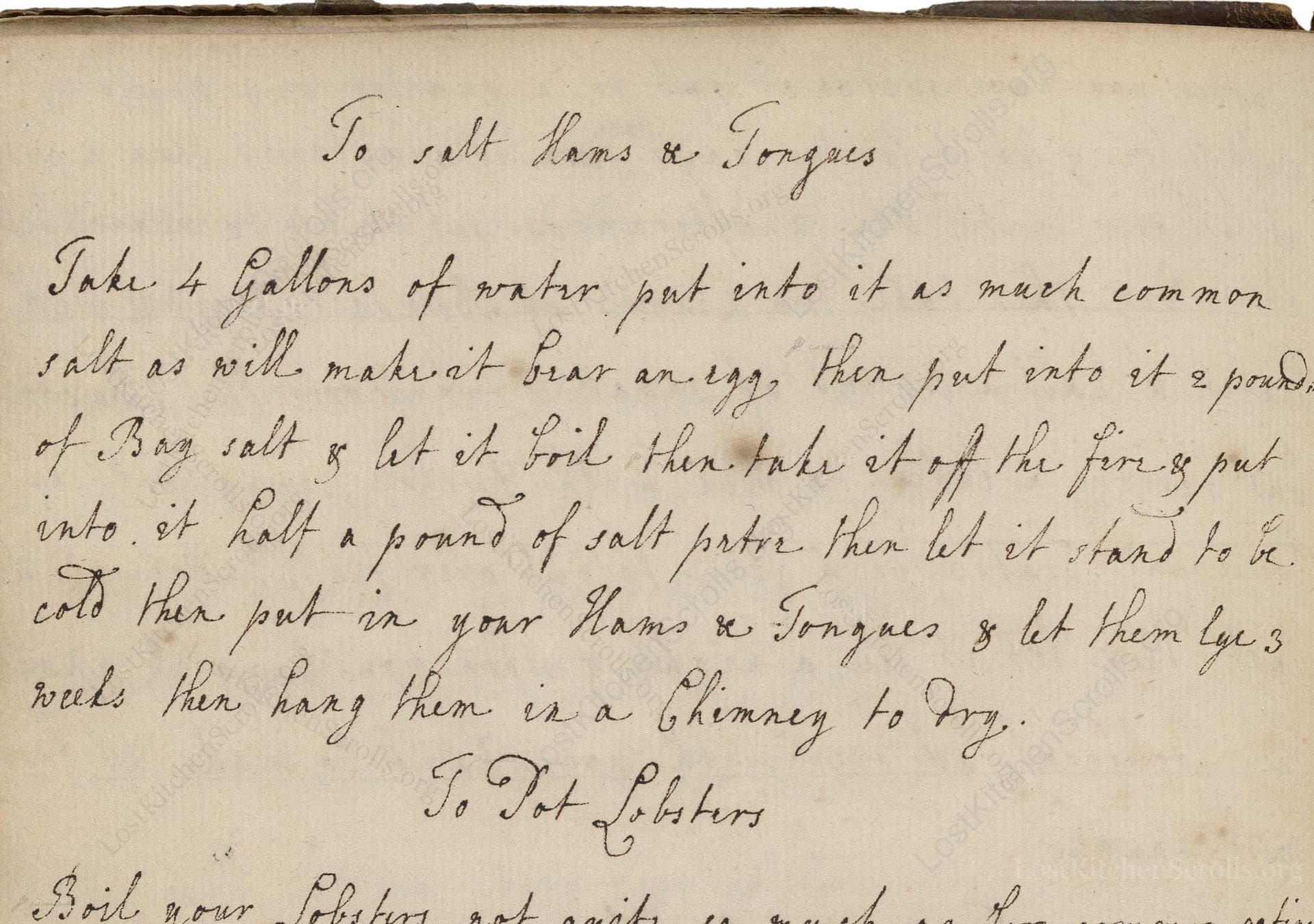To Salt Hams & Tongues
From the treasured pages of Cookbook of Elizabeth Langley
Written by Elizabeth Langley

To Salt Hams & Tongues
"Take 4 Gallons of water put into it as much common salt as will make it bear an egg, then put into it 2 pounds of Bay salt & let it boil. then take it of the fire & put into it half a pound of salt petre then let it stand to be cold then put in your Hams & Tongues & let them lye 3 weeks then hang them in a Chimney to Dry."
Note on the Original Text
The recipe is brief, direct, and assumes the reader has baseline knowledge of meat preservation. Units are vague by modern standards—'as much salt as will make it bear an egg' was a common quick test for the correct saline strength. Spelling is typical of the eighteenth century: 'lye' for 'lie', and 'take it of the fire' meaning 'remove it from the heat.' Such recipes rarely specify precise temperatures or weights, relying on tactile cues and traditional household wisdom. The use of saltpetre underlines the period's awareness of chemical preservation, even if its health effects were not yet widely understood.

Title
Cookbook of Elizabeth Langley (1757)
You can also click the book image above to peruse the original tome
Writer
Elizabeth Langley
Era
1757
Publisher
Unknown
Background
Step into the Georgian kitchen with Elizabeth Langley's 1757 culinary collection, where refined techniques and delightful recipes await those with a taste for historic gastronomy.
Kindly made available by
Folger Shakespeare Library
This recipe comes from an English manuscript written in 1757 by Elizabeth Langley, during a time when home curing was essential for preserving valuable pork and beef products before the advent of refrigeration. Salting and drying were household arts, often undertaken in the cooler months to ensure meat could last through the year. The recipe reflects both practical knowledge and the domestic rituals of Georgian England, where households took great pride in their own preserved meats, aided by the accessible technology of open fires, brine solutions, and the drafty architecture perfect for drying.

In Elizabeth Langley's day, the cook would rely on sturdy wooden tubs or barrels for brining, large cauldrons or iron pots for boiling the salt solution, wooden paddles or spoons for stirring, and a sharp knife for trimming the cuts of meat. Hanging and drying would be accomplished in the broad chimneys of period kitchens—effectively using the updraft and residual warmth for safe curing. No modern refrigeration or plastic tubs were available, making careful monitoring essential.
Prep Time
1 hr
Cook Time
0 mins
Servings
30
We've done our best to adapt this historical recipe for modern kitchens, but some details may still need refinement. We warmly welcome feedback from fellow cooks and culinary historians — your insights support the entire community!
Ingredients
- 4 gallons water
- Enough table salt (common salt) to float an egg (approximately 4–5 pounds)
- 2 pounds bay salt (or substitute with coarse sea salt)
- 8 ounces saltpetre (potassium nitrate) or Prague powder #1 curing salt (see safety notes)
- Whole fresh hams (pork), quantity as fits in brine
- Whole beef tongues (as desired)
Instructions
- To create a savory salted ham and tongue in the spirit of the 18th century, begin by dissolving enough common salt (table salt) into about 4 gallons of water until a fresh egg floats—this will be your brine.
- Bring this to a boil with 2 pounds of bay salt (or coarse sea salt as a modern substitute), then remove from the heat and stir in 8 ounces of saltpetre (potassium nitrate, though use with caution; food-grade Prague powder #1 curing salt is a modern, safer substitute).
- Allow the brine to cool completely.
- Submerge your cleaned and trimmed hams and beef tongues fully in the brine.
- Let them soak for three weeks, occasionally checking to ensure they remain submerged and the brine is free of spoilage.
- After three weeks, remove the meats, drain thoroughly, and hang in a well-ventilated area or smokehouse to dry, mimicking the chimney drying of the past.
- The result: preserved, deeply seasoned meats, ready for slicing or further cooking.
Estimated Calories
250 per serving
Cooking Estimates
Preparing and brining the meat takes some time, but most of it is waiting while the meat cures in the salty mixture. Actual hands-on work is much shorter. We estimate calories based on an average 100g serving of cured ham or tongue.
As noted above, we have made our best effort to translate and adapt this historical recipe for modern kitchens, taking into account ingredients nowadays, cooking techniques, measurements, and so on. However, historical recipes often contain assumptions that require interpretation.
We'd love for anyone to help improve these adaptations. Community contributions are highly welcome. If you have suggestions, corrections, or cooking tips based on your experience with this recipe, please share them below.
Join the Discussion
Rate This Recipe
Dietary Preference
Main Ingredients
Occasions

Den Bockfisch In Einer Fleisch Suppen Zu Kochen
This recipe hails from a German manuscript cookbook compiled in 1696, a time whe...

Die Grieß Nudlen Zumachen
This recipe comes from a rather mysterious manuscript cookbook, penned anonymous...

Ein Boudain
This recipe comes from an anonymous German-language manuscript cookbook from 169...

Ein Gesaltzen Citroni
This recipe, dating from 1696, comes from an extensive anonymous German cookbook...
Browse our complete collection of time-honored recipes



